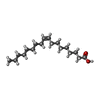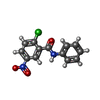[English] 日本語
 Yorodumi
Yorodumi- PDB-6md1: Crystal Structure of Human PPARgamma Ligand Binding Domain in Com... -
+ Open data
Open data
- Basic information
Basic information
| Entry | Database: PDB / ID: 6md1 | ||||||
|---|---|---|---|---|---|---|---|
| Title | Crystal Structure of Human PPARgamma Ligand Binding Domain in Complex with GW9662 and Oleic acid | ||||||
 Components Components | Peroxisome proliferator-activated receptor gamma | ||||||
 Keywords Keywords |  TRANSCRIPTION / TRANSCRIPTION /  Nuclear receptors / TZDs / Nuclear receptors / TZDs /  Drug design / Therapeutic targets Drug design / Therapeutic targets | ||||||
| Function / homology |  Function and homology information Function and homology information prostaglandin receptor activity / regulation of cholesterol transporter activity / negative regulation of connective tissue replacement involved in inflammatory response wound healing / negative regulation of receptor signaling pathway via STAT / MECP2 regulates transcription factors / negative regulation of extracellular matrix assembly / negative regulation of vascular endothelial cell proliferation / negative regulation of cellular response to transforming growth factor beta stimulus / negative regulation of cardiac muscle hypertrophy in response to stress / prostaglandin receptor activity / regulation of cholesterol transporter activity / negative regulation of connective tissue replacement involved in inflammatory response wound healing / negative regulation of receptor signaling pathway via STAT / MECP2 regulates transcription factors / negative regulation of extracellular matrix assembly / negative regulation of vascular endothelial cell proliferation / negative regulation of cellular response to transforming growth factor beta stimulus / negative regulation of cardiac muscle hypertrophy in response to stress /  arachidonic acid binding ... arachidonic acid binding ... prostaglandin receptor activity / regulation of cholesterol transporter activity / negative regulation of connective tissue replacement involved in inflammatory response wound healing / negative regulation of receptor signaling pathway via STAT / MECP2 regulates transcription factors / negative regulation of extracellular matrix assembly / negative regulation of vascular endothelial cell proliferation / negative regulation of cellular response to transforming growth factor beta stimulus / negative regulation of cardiac muscle hypertrophy in response to stress / prostaglandin receptor activity / regulation of cholesterol transporter activity / negative regulation of connective tissue replacement involved in inflammatory response wound healing / negative regulation of receptor signaling pathway via STAT / MECP2 regulates transcription factors / negative regulation of extracellular matrix assembly / negative regulation of vascular endothelial cell proliferation / negative regulation of cellular response to transforming growth factor beta stimulus / negative regulation of cardiac muscle hypertrophy in response to stress /  arachidonic acid binding / positive regulation of low-density lipoprotein receptor activity / positive regulation of adiponectin secretion / lipoprotein transport / negative regulation of sequestering of triglyceride / positive regulation of vascular associated smooth muscle cell apoptotic process / macrophage derived foam cell differentiation / arachidonic acid binding / positive regulation of low-density lipoprotein receptor activity / positive regulation of adiponectin secretion / lipoprotein transport / negative regulation of sequestering of triglyceride / positive regulation of vascular associated smooth muscle cell apoptotic process / macrophage derived foam cell differentiation /  DNA binding domain binding / STAT family protein binding / positive regulation of fatty acid metabolic process / response to lipid / negative regulation of SMAD protein signal transduction / LBD domain binding / negative regulation of type II interferon-mediated signaling pathway / negative regulation of cholesterol storage / DNA binding domain binding / STAT family protein binding / positive regulation of fatty acid metabolic process / response to lipid / negative regulation of SMAD protein signal transduction / LBD domain binding / negative regulation of type II interferon-mediated signaling pathway / negative regulation of cholesterol storage /  E-box binding / alpha-actinin binding / negative regulation of blood vessel endothelial cell migration / lipid homeostasis / negative regulation of vascular associated smooth muscle cell proliferation / E-box binding / alpha-actinin binding / negative regulation of blood vessel endothelial cell migration / lipid homeostasis / negative regulation of vascular associated smooth muscle cell proliferation /  R-SMAD binding / monocyte differentiation / positive regulation of cholesterol efflux / negative regulation of macrophage derived foam cell differentiation / cellular response to low-density lipoprotein particle stimulus / negative regulation of lipid storage / negative regulation of BMP signaling pathway / white fat cell differentiation / negative regulation of mitochondrial fission / positive regulation of fat cell differentiation / negative regulation of osteoblast differentiation / long-chain fatty acid transport / retinoic acid receptor signaling pathway / positive regulation of DNA binding / R-SMAD binding / monocyte differentiation / positive regulation of cholesterol efflux / negative regulation of macrophage derived foam cell differentiation / cellular response to low-density lipoprotein particle stimulus / negative regulation of lipid storage / negative regulation of BMP signaling pathway / white fat cell differentiation / negative regulation of mitochondrial fission / positive regulation of fat cell differentiation / negative regulation of osteoblast differentiation / long-chain fatty acid transport / retinoic acid receptor signaling pathway / positive regulation of DNA binding /  cell fate commitment / BMP signaling pathway / nuclear retinoid X receptor binding / negative regulation of signaling receptor activity / regulation of cellular response to insulin stimulus / cell maturation / positive regulation of adipose tissue development / epithelial cell differentiation / peroxisome proliferator activated receptor signaling pathway / hormone-mediated signaling pathway / negative regulation of angiogenesis / response to nutrient / negative regulation of MAP kinase activity / fatty acid metabolic process / negative regulation of miRNA transcription / placenta development / Regulation of PTEN gene transcription / negative regulation of smooth muscle cell proliferation / cell fate commitment / BMP signaling pathway / nuclear retinoid X receptor binding / negative regulation of signaling receptor activity / regulation of cellular response to insulin stimulus / cell maturation / positive regulation of adipose tissue development / epithelial cell differentiation / peroxisome proliferator activated receptor signaling pathway / hormone-mediated signaling pathway / negative regulation of angiogenesis / response to nutrient / negative regulation of MAP kinase activity / fatty acid metabolic process / negative regulation of miRNA transcription / placenta development / Regulation of PTEN gene transcription / negative regulation of smooth muscle cell proliferation /  transcription coregulator binding / transcription coregulator binding /  peptide binding / negative regulation of transforming growth factor beta receptor signaling pathway / SUMOylation of intracellular receptors / mRNA transcription by RNA polymerase II / lipid metabolic process / peptide binding / negative regulation of transforming growth factor beta receptor signaling pathway / SUMOylation of intracellular receptors / mRNA transcription by RNA polymerase II / lipid metabolic process /  regulation of circadian rhythm / PPARA activates gene expression / negative regulation of inflammatory response / DNA-binding transcription repressor activity, RNA polymerase II-specific / regulation of circadian rhythm / PPARA activates gene expression / negative regulation of inflammatory response / DNA-binding transcription repressor activity, RNA polymerase II-specific /  regulation of blood pressure / Transcriptional regulation of white adipocyte differentiation / positive regulation of miRNA transcription / Nuclear Receptor transcription pathway / RNA polymerase II transcription regulator complex / cellular response to insulin stimulus / activation of cysteine-type endopeptidase activity involved in apoptotic process / rhythmic process / : / regulation of blood pressure / Transcriptional regulation of white adipocyte differentiation / positive regulation of miRNA transcription / Nuclear Receptor transcription pathway / RNA polymerase II transcription regulator complex / cellular response to insulin stimulus / activation of cysteine-type endopeptidase activity involved in apoptotic process / rhythmic process / : /  nuclear receptor activity / positive regulation of DNA-binding transcription factor activity / nuclear receptor activity / positive regulation of DNA-binding transcription factor activity /  glucose homeostasis / cellular response to hypoxia / glucose homeostasis / cellular response to hypoxia /  double-stranded DNA binding / DNA-binding transcription activator activity, RNA polymerase II-specific / DNA-binding transcription factor binding / sequence-specific DNA binding / double-stranded DNA binding / DNA-binding transcription activator activity, RNA polymerase II-specific / DNA-binding transcription factor binding / sequence-specific DNA binding /  cell differentiation / cell differentiation /  nucleic acid binding / nucleic acid binding /  receptor complex / transcription cis-regulatory region binding / DNA-binding transcription factor activity, RNA polymerase II-specific / RNA polymerase II cis-regulatory region sequence-specific DNA binding / DNA-binding transcription factor activity / negative regulation of gene expression / receptor complex / transcription cis-regulatory region binding / DNA-binding transcription factor activity, RNA polymerase II-specific / RNA polymerase II cis-regulatory region sequence-specific DNA binding / DNA-binding transcription factor activity / negative regulation of gene expression /  innate immune response / intracellular membrane-bounded organelle / negative regulation of DNA-templated transcription / innate immune response / intracellular membrane-bounded organelle / negative regulation of DNA-templated transcription /  chromatin binding chromatin bindingSimilarity search - Function | ||||||
| Biological species |   Homo sapiens (human) Homo sapiens (human) | ||||||
| Method |  X-RAY DIFFRACTION / X-RAY DIFFRACTION /  SYNCHROTRON / SYNCHROTRON /  MOLECULAR REPLACEMENT / Resolution: 2.2 Å MOLECULAR REPLACEMENT / Resolution: 2.2 Å | ||||||
 Authors Authors | Shang, J. / Kojetin, D.J. | ||||||
| Funding support |  United States, 1items United States, 1items
| ||||||
 Citation Citation |  Journal: Elife / Year: 2018 Journal: Elife / Year: 2018Title: Cooperative cobinding of synthetic and natural ligands to the nuclear receptor PPAR gamma. Authors: Shang, J. / Brust, R. / Mosure, S.A. / Bass, J. / Munoz-Tello, P. / Lin, H. / Hughes, T.S. / Tang, M. / Ge, Q. / Kamekencka, T.M. / Kojetin, D.J. | ||||||
| History |
|
- Structure visualization
Structure visualization
| Structure viewer | Molecule:  Molmil Molmil Jmol/JSmol Jmol/JSmol |
|---|
- Downloads & links
Downloads & links
- Download
Download
| PDBx/mmCIF format |  6md1.cif.gz 6md1.cif.gz | 121.7 KB | Display |  PDBx/mmCIF format PDBx/mmCIF format |
|---|---|---|---|---|
| PDB format |  pdb6md1.ent.gz pdb6md1.ent.gz | 93.2 KB | Display |  PDB format PDB format |
| PDBx/mmJSON format |  6md1.json.gz 6md1.json.gz | Tree view |  PDBx/mmJSON format PDBx/mmJSON format | |
| Others |  Other downloads Other downloads |
-Validation report
| Arichive directory |  https://data.pdbj.org/pub/pdb/validation_reports/md/6md1 https://data.pdbj.org/pub/pdb/validation_reports/md/6md1 ftp://data.pdbj.org/pub/pdb/validation_reports/md/6md1 ftp://data.pdbj.org/pub/pdb/validation_reports/md/6md1 | HTTPS FTP |
|---|
-Related structure data
| Related structure data |  5ugmC 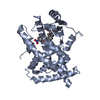 6augC  6aviC 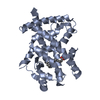 6mczC  6md0C  6md2C  6md4C 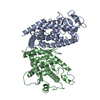 1prgS S: Starting model for refinement C: citing same article ( |
|---|---|
| Similar structure data |
- Links
Links
- Assembly
Assembly
| Deposited unit | 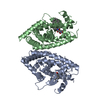
| ||||||||
|---|---|---|---|---|---|---|---|---|---|
| 1 | 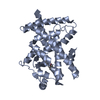
| ||||||||
| 2 | 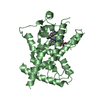
| ||||||||
| Unit cell |
|
- Components
Components
| #1: Protein |  / PPAR-gamma / Nuclear receptor subfamily 1 group C member 3 / PPAR-gamma / Nuclear receptor subfamily 1 group C member 3Mass: 31449.520 Da / Num. of mol.: 2 Source method: isolated from a genetically manipulated source Source: (gene. exp.)   Homo sapiens (human) / Gene: PPARG, NR1C3 / Plasmid: pET46 / Production host: Homo sapiens (human) / Gene: PPARG, NR1C3 / Plasmid: pET46 / Production host:   Escherichia coli BL21(DE3) (bacteria) / Strain (production host): BL21(DE3) / References: UniProt: P37231 Escherichia coli BL21(DE3) (bacteria) / Strain (production host): BL21(DE3) / References: UniProt: P37231#2: Chemical |  Oleic acid Oleic acid#3: Chemical | ChemComp-GW9 / | #4: Water | ChemComp-HOH / |  Water Water |
|---|
-Experimental details
-Experiment
| Experiment | Method:  X-RAY DIFFRACTION / Number of used crystals: 1 X-RAY DIFFRACTION / Number of used crystals: 1 |
|---|
- Sample preparation
Sample preparation
| Crystal | Density Matthews: 2.64 Å3/Da / Density % sol: 53.35 % |
|---|---|
Crystal grow | Temperature: 293 K / Method: vapor diffusion, sitting drop / pH: 7.4 / Details: 0.1M MOPS, pH 7.4 0.8M Sodium Citrate |
-Data collection
| Diffraction | Mean temperature: 100 K |
|---|---|
| Diffraction source | Source:  SYNCHROTRON / Site: SYNCHROTRON / Site:  SSRL SSRL  / Beamline: BL12-2 / Wavelength: 0.97946 Å / Beamline: BL12-2 / Wavelength: 0.97946 Å |
| Detector | Type: DECTRIS PILATUS3 S 6M / Detector: PIXEL / Date: May 4, 2018 / Details: Liquid nitrogen-cooled double crystal Si(111) |
| Radiation | Protocol: SINGLE WAVELENGTH / Monochromatic (M) / Laue (L): M / Scattering type: x-ray |
| Radiation wavelength | Wavelength : 0.97946 Å / Relative weight: 1 : 0.97946 Å / Relative weight: 1 |
| Reflection | Resolution: 2.2→39.51 Å / Num. obs: 32923 / % possible obs: 98.2 % / Redundancy: 2 % / Biso Wilson estimate: 22.04 Å2 / CC1/2: 1 / Rmerge(I) obs: 0.014 / Rpim(I) all: 0.01377 / Rrim(I) all: 0.01947 / Net I/σ(I): 17.74 |
| Reflection shell | Resolution: 2.2→2.28 Å / Redundancy: 2 % / Rmerge(I) obs: 0.282 / Mean I/σ(I) obs: 2.57 / CC1/2: 0.91 / Rpim(I) all: 0.2825 / Rrim(I) all: 0.3995 / % possible all: 97.9 |
- Processing
Processing
| Software |
| |||||||||||||||||||||||||||||||||||||||||||||||||||||||||||||||||||||||||||||||||||||||||||||||||||||||||
|---|---|---|---|---|---|---|---|---|---|---|---|---|---|---|---|---|---|---|---|---|---|---|---|---|---|---|---|---|---|---|---|---|---|---|---|---|---|---|---|---|---|---|---|---|---|---|---|---|---|---|---|---|---|---|---|---|---|---|---|---|---|---|---|---|---|---|---|---|---|---|---|---|---|---|---|---|---|---|---|---|---|---|---|---|---|---|---|---|---|---|---|---|---|---|---|---|---|---|---|---|---|---|---|---|---|---|
| Refinement | Method to determine structure : :  MOLECULAR REPLACEMENT MOLECULAR REPLACEMENTStarting model: 1PRG Resolution: 2.2→39.51 Å / SU ML: 0.32 / Cross valid method: THROUGHOUT / σ(F): 1.35 / Phase error: 28.91
| |||||||||||||||||||||||||||||||||||||||||||||||||||||||||||||||||||||||||||||||||||||||||||||||||||||||||
| Solvent computation | Shrinkage radii: 0.9 Å / VDW probe radii: 1.11 Å | |||||||||||||||||||||||||||||||||||||||||||||||||||||||||||||||||||||||||||||||||||||||||||||||||||||||||
| Displacement parameters | Biso max: 116.41 Å2 / Biso mean: 32.34 Å2 / Biso min: 6.8 Å2 | |||||||||||||||||||||||||||||||||||||||||||||||||||||||||||||||||||||||||||||||||||||||||||||||||||||||||
| Refinement step | Cycle: final / Resolution: 2.2→39.51 Å
| |||||||||||||||||||||||||||||||||||||||||||||||||||||||||||||||||||||||||||||||||||||||||||||||||||||||||
| LS refinement shell | Refine-ID: X-RAY DIFFRACTION / Rfactor Rfree error: 0 / Total num. of bins used: 14
|
 Movie
Movie Controller
Controller


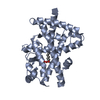
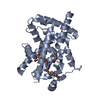
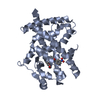
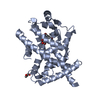

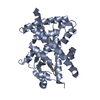
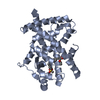
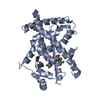
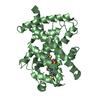
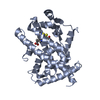
 PDBj
PDBj



